 CN
CN info@seacomould.com
info@seacomould.com +86-18969612882
+86-18969612882
How much impact will the epidemic have on the urban economy
2020-02-08
With the gradual spread of new coronavirus-infected pneumonia, various research institutions have analyzed the trend of macroeconomic trends in China in the future after the outbreak, and have also formed a series of measures. Taken together, the research results of all parties believe that the impact on the catering, tourism, and film industries will be significant, and it will have a certain impact on the stability of China's economy. The research from various parties also provides a series of policies, including fiscal and monetary policies. Suggest. CCID Consulting believes that 2020 will be a year of building a well-off society in an all-round way, realizing the first century-long struggle, and laying the foundation for the development of the "Fourteenth Five-Year Plan". In such an era, it is even more important to consider the epidemic situation to the high quality of the economy The impact of development should not be limited to the service sector that has been affected by the epidemic.
Based on the industrial brain of CCID, this study took 250 key cities in China as the research object after the SARS epidemic in 2003, and used a total of about 40,000 statistics from 2001 to 2016 for data analysis to calculate the economic impact of each industry category on the post-epidemic economy. The contribution of growth is as follows:
Conclusion 1: The national epidemic, taking SARS as an example, has a certain impact on China's macro economy. After the SARS epidemic, the impact on the service industry in the short term is greater than that in the manufacturing industry, and the impact on the macro economy is small in the long term.
Conclusion 2: In the year of SARS epidemic (ie 2003), the contribution of manufacturing to economic growth was not only greater than the contribution of the service industry in that year, but also greater than the contribution of manufacturing in neighboring years, indicating that the manufacturing industry has a higher contribution rate to economic growth after the epidemic .
Conclusion 3: Cities with a high proportion of manufacturing industries recovered faster and more efficiently after the SARS epidemic.
Conclusion 4: Combining the distribution of the epidemic situation and urban conditions at this stage, cities in the central region are relatively affected by the epidemic situation, and the role of manufacturing in stable growth should be emphasized.
I. After the SARS epidemic, the manufacturing industry has made greater contributions to stable economic growth
The impact of the traditional SARS epidemic on the macroeconomy is mainly based on the statistics of the country and major provinces, and the number of samples is relatively small. This study combined the accumulation of urban statistical data to select a long and diverse two years before the start of the SARA epidemic. Panel analysis of this city's statistical data (about 40,000 items in total). We used a fixed-effect template regression model to calculate the regression coefficients of the secondary industry and the tertiary industry on regional GDP after the SARS epidemic occurred, and used to characterize the contribution to the economy, as shown in Table 1.
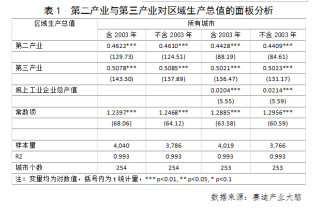
From the results, it can be seen that the regression coefficient of the secondary industry with 2003 is greater than the regression coefficient of the secondary industry without 2003. The larger the regression coefficient, the lower the contribution. This proves that after the SARS epidemic (ie 2003), The main secondary industry contributes a large proportion to economic growth. It can also be seen from the results that the regression coefficient of the tertiary industry with 2003 is smaller than that without 2003, indicating that the contribution of the tertiary industry in the year when the epidemic occurred was reduced.
Considering the diversity and uneven development of cities in China, we controlled the variables such as investment, consumption, fiscal revenue, and population, and analyzed the data with an OLS model to verify the above conclusions, as shown in Table 2. We also used the OLS model to analyze the cross-section data for the year 2003. The results show that during the SARS epidemic, the contribution and efficiency of the secondary industry, especially the manufacturing industry, in maintaining economic growth performed better than the tertiary industry.
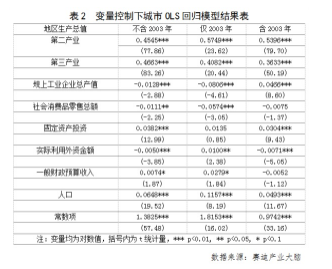
Second, cities with a large proportion of manufacturing industries are recovering faster and more efficiently.
In order to better study and analyze the role of manufacturing industry in urban economic growth after the outbreak, we grouped the cities based on the proportion of urban secondary industries in 2003 exceeding 50%. Degree of speed and efficiency. An example of the urban secondary industry in 2003 is shown in Figure 1.
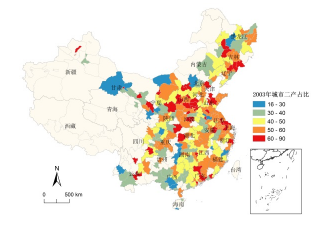
Figure 1 Distribution of the proportion of secondary industries in Chinese cities in 2003
We use this group to perform panel analysis on the data from 2001 to 2016, and also use the OLS model to obtain the results, as shown in Table 3. It can be seen from the results that cities with a high proportion of manufacturing industry recovered faster and more efficiently after the SARS epidemic, indicating that the economic recovery and sustained growth of the manufacturing industry after the outbreak of the city played a very important role.
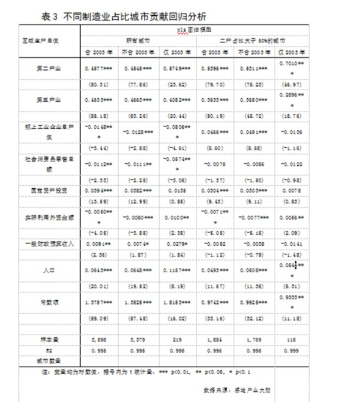
Three, cities in the central region have been severely affected by the epidemic
Based on the above conclusions and the distribution of new coronavirus infections in various provinces and cities as of the end of January, we predict the economic impact of domestic cities in the next one to three years, divided into first, second, third, and fourth levels, one of which The level is the highest level, which indicates that it is most affected. The prediction is shown in Table 2.
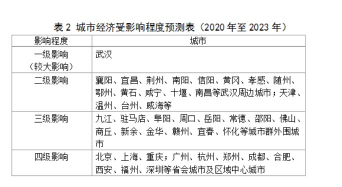
As a concentrated outbreak of this epidemic, Wuhan's economic development will be greatly affected in the short term. From the inside, Wuhan ’s "closed city" is also expected to be lifted at the earliest and later, and the downtime of enterprises will be longer, and the impact on the urban economy will continue for a long time. From the outside, many countries and regions directly call the epidemic "Wuhan Virus", and the WTO characterizes the epidemic as a public health emergency of international concern. This casts a shadow, which will cause some difficulties for Wuhan's investment promotion work, especially attracting foreign investment in the future. However, as an important industrial base in China, Wuhan has a complete range of industries and abundant scientific and educational resources. In recent years, with the implementation of a number of major projects such as the Yangtze River Storage, the city still has great potential for economic development. The economic impact of Wuhan is relatively small.
With the exception of Wuhan, we believe that other cities in Hubei and neighboring provinces such as Henan, Shanxi, and Hunan will be generally affected. The epidemic situation in Hubei and other cities is relatively serious. At the same time, the industrial structure is relatively simple, and the economic growth pressure is greater after the epidemic. Outlying cities near Hubei, such as Nanyang and Xinyang in Henan, and Nanchang in Jiangxi are expected to be affected by the epidemic. At the same time, taking into account the epidemic situation and the impact of the corresponding shutdown, foreign trade pressures in Tianjin, Wenzhou, Zhejiang, Taizhou and Shandong Weihai will further increase, and the urban economy will be affected to some extent.
At the same time, considering the industrial structure, hierarchy, and distribution of key projects, we believe that the outlying cities in the urban agglomeration will also be affected after the epidemic. The peripheral cities of the urban agglomeration are mostly small and medium-sized cities, lacking large projects and large industries, and the stability of the industry is low. After the epidemic is over, it is prone to systemic chain reactions due to the impact of shutdowns, and the downward pressure on the urban economy is greater. Beijing, Shanghai and other urban agglomerations and capital cities are relatively high-level industries. Although they will be affected by shutdowns and other issues in the near future, they are expected to recover rapidly from a time scale of 1 to 2 years. In other cities.
4. Attach importance to the stable growth of the manufacturing industry after the epidemic
This paper quantitatively analyzes the performance of Chinese cities after the SARS epidemic, and proves that the manufacturing industry has an extremely important role in the steady economic growth after the epidemic. In order to give play to the role of the economy as a "ballast stone" in the short term after the epidemic, it is recommended to strengthen the policy supply to the manufacturing industry after the recent epidemic of new-type coronavirus infection pneumonia has stabilized. The focus includes three aspects.
The first is to accelerate the activation of the consumption potential of terminal products and tap the increase in foreign trade exports. In 2003, China ’s auto production and sales increased by more than 1 million vehicles in a year, effectively boosting the overall growth of the manufacturing industry, effectively stimulating the rapid recovery of the economy, and reducing the duration of the impact of the SARS epidemic on the economy. It is suggested that after this new coronavirus infection pneumonia epidemic stabilizes, it will encourage residents to spend on upgrading demand for durable consumer goods and other fields, refine the lifting of automobile purchase restrictions, and promote a series of stimulus policies such as updating and upgrading key consumer goods. In terms of opening to the outside world, we will speed up the overall opening up, accelerate economic and trade exchanges with the “Belt and Road” countries, and promote the steady growth of China's merchandise trade.
The second is to do well in advance to reserve infrastructure projects. Infrastructure projects have a certain stimulating and stimulating effect on the entire industrial chain of the manufacturing industry. The fifth meeting of the Central Finance and Economic Committee in 2019 has determined the overall regional development strategy of “promoting the formation of a regional economic layout with complementary complementary high-quality development”, but Through this epidemic, we can also see that the central cities of urban agglomerations still face the problem of inadequate infrastructure, especially livelihood facilities, in the face of population inflows. In order to stimulate the development of manufacturing industry, infrastructure project reserves should be made ahead of schedule, and a batch of infrastructure project constructions serving the central cities of urban agglomerations should be accelerated. At the same time, we summarized the shortage of material reserves, especially emergency products and equipment reserves, and issued a systemic policy to accelerate the production of related products and equipment.
The third is to increase subsidies and support for manufacturing, especially advanced manufacturing. After the SARS outbreak, the country introduced a series of tax reduction and exemption policies, but mainly targeted at the transportation, tourism, catering and other sectors that were directly affected by the epidemic, and the coverage of manufacturing was low. However, as analyzed above, the manufacturing industry, especially the advanced manufacturing industry, has played a very important role in stabilizing the high-quality economic growth and improving China's comprehensive competitiveness. It should further provide tax and fee reduction policies on the existing basis. At the same time, more targeted policies should be introduced for key areas of advanced manufacturing to further promote the development of manufacturing, especially advanced manufacturing.
Based on the industrial brain of CCID, this study took 250 key cities in China as the research object after the SARS epidemic in 2003, and used a total of about 40,000 statistics from 2001 to 2016 for data analysis to calculate the economic impact of each industry category on the post-epidemic economy. The contribution of growth is as follows:
Conclusion 1: The national epidemic, taking SARS as an example, has a certain impact on China's macro economy. After the SARS epidemic, the impact on the service industry in the short term is greater than that in the manufacturing industry, and the impact on the macro economy is small in the long term.
Conclusion 2: In the year of SARS epidemic (ie 2003), the contribution of manufacturing to economic growth was not only greater than the contribution of the service industry in that year, but also greater than the contribution of manufacturing in neighboring years, indicating that the manufacturing industry has a higher contribution rate to economic growth after the epidemic .
Conclusion 3: Cities with a high proportion of manufacturing industries recovered faster and more efficiently after the SARS epidemic.
Conclusion 4: Combining the distribution of the epidemic situation and urban conditions at this stage, cities in the central region are relatively affected by the epidemic situation, and the role of manufacturing in stable growth should be emphasized.
I. After the SARS epidemic, the manufacturing industry has made greater contributions to stable economic growth
The impact of the traditional SARS epidemic on the macroeconomy is mainly based on the statistics of the country and major provinces, and the number of samples is relatively small. This study combined the accumulation of urban statistical data to select a long and diverse two years before the start of the SARA epidemic. Panel analysis of this city's statistical data (about 40,000 items in total). We used a fixed-effect template regression model to calculate the regression coefficients of the secondary industry and the tertiary industry on regional GDP after the SARS epidemic occurred, and used to characterize the contribution to the economy, as shown in Table 1.

From the results, it can be seen that the regression coefficient of the secondary industry with 2003 is greater than the regression coefficient of the secondary industry without 2003. The larger the regression coefficient, the lower the contribution. This proves that after the SARS epidemic (ie 2003), The main secondary industry contributes a large proportion to economic growth. It can also be seen from the results that the regression coefficient of the tertiary industry with 2003 is smaller than that without 2003, indicating that the contribution of the tertiary industry in the year when the epidemic occurred was reduced.
Considering the diversity and uneven development of cities in China, we controlled the variables such as investment, consumption, fiscal revenue, and population, and analyzed the data with an OLS model to verify the above conclusions, as shown in Table 2. We also used the OLS model to analyze the cross-section data for the year 2003. The results show that during the SARS epidemic, the contribution and efficiency of the secondary industry, especially the manufacturing industry, in maintaining economic growth performed better than the tertiary industry.

Second, cities with a large proportion of manufacturing industries are recovering faster and more efficiently.
In order to better study and analyze the role of manufacturing industry in urban economic growth after the outbreak, we grouped the cities based on the proportion of urban secondary industries in 2003 exceeding 50%. Degree of speed and efficiency. An example of the urban secondary industry in 2003 is shown in Figure 1.

Figure 1 Distribution of the proportion of secondary industries in Chinese cities in 2003
We use this group to perform panel analysis on the data from 2001 to 2016, and also use the OLS model to obtain the results, as shown in Table 3. It can be seen from the results that cities with a high proportion of manufacturing industry recovered faster and more efficiently after the SARS epidemic, indicating that the economic recovery and sustained growth of the manufacturing industry after the outbreak of the city played a very important role.

Three, cities in the central region have been severely affected by the epidemic
Based on the above conclusions and the distribution of new coronavirus infections in various provinces and cities as of the end of January, we predict the economic impact of domestic cities in the next one to three years, divided into first, second, third, and fourth levels, one of which The level is the highest level, which indicates that it is most affected. The prediction is shown in Table 2.

As a concentrated outbreak of this epidemic, Wuhan's economic development will be greatly affected in the short term. From the inside, Wuhan ’s "closed city" is also expected to be lifted at the earliest and later, and the downtime of enterprises will be longer, and the impact on the urban economy will continue for a long time. From the outside, many countries and regions directly call the epidemic "Wuhan Virus", and the WTO characterizes the epidemic as a public health emergency of international concern. This casts a shadow, which will cause some difficulties for Wuhan's investment promotion work, especially attracting foreign investment in the future. However, as an important industrial base in China, Wuhan has a complete range of industries and abundant scientific and educational resources. In recent years, with the implementation of a number of major projects such as the Yangtze River Storage, the city still has great potential for economic development. The economic impact of Wuhan is relatively small.
With the exception of Wuhan, we believe that other cities in Hubei and neighboring provinces such as Henan, Shanxi, and Hunan will be generally affected. The epidemic situation in Hubei and other cities is relatively serious. At the same time, the industrial structure is relatively simple, and the economic growth pressure is greater after the epidemic. Outlying cities near Hubei, such as Nanyang and Xinyang in Henan, and Nanchang in Jiangxi are expected to be affected by the epidemic. At the same time, taking into account the epidemic situation and the impact of the corresponding shutdown, foreign trade pressures in Tianjin, Wenzhou, Zhejiang, Taizhou and Shandong Weihai will further increase, and the urban economy will be affected to some extent.
At the same time, considering the industrial structure, hierarchy, and distribution of key projects, we believe that the outlying cities in the urban agglomeration will also be affected after the epidemic. The peripheral cities of the urban agglomeration are mostly small and medium-sized cities, lacking large projects and large industries, and the stability of the industry is low. After the epidemic is over, it is prone to systemic chain reactions due to the impact of shutdowns, and the downward pressure on the urban economy is greater. Beijing, Shanghai and other urban agglomerations and capital cities are relatively high-level industries. Although they will be affected by shutdowns and other issues in the near future, they are expected to recover rapidly from a time scale of 1 to 2 years. In other cities.
4. Attach importance to the stable growth of the manufacturing industry after the epidemic
This paper quantitatively analyzes the performance of Chinese cities after the SARS epidemic, and proves that the manufacturing industry has an extremely important role in the steady economic growth after the epidemic. In order to give play to the role of the economy as a "ballast stone" in the short term after the epidemic, it is recommended to strengthen the policy supply to the manufacturing industry after the recent epidemic of new-type coronavirus infection pneumonia has stabilized. The focus includes three aspects.
The first is to accelerate the activation of the consumption potential of terminal products and tap the increase in foreign trade exports. In 2003, China ’s auto production and sales increased by more than 1 million vehicles in a year, effectively boosting the overall growth of the manufacturing industry, effectively stimulating the rapid recovery of the economy, and reducing the duration of the impact of the SARS epidemic on the economy. It is suggested that after this new coronavirus infection pneumonia epidemic stabilizes, it will encourage residents to spend on upgrading demand for durable consumer goods and other fields, refine the lifting of automobile purchase restrictions, and promote a series of stimulus policies such as updating and upgrading key consumer goods. In terms of opening to the outside world, we will speed up the overall opening up, accelerate economic and trade exchanges with the “Belt and Road” countries, and promote the steady growth of China's merchandise trade.
The second is to do well in advance to reserve infrastructure projects. Infrastructure projects have a certain stimulating and stimulating effect on the entire industrial chain of the manufacturing industry. The fifth meeting of the Central Finance and Economic Committee in 2019 has determined the overall regional development strategy of “promoting the formation of a regional economic layout with complementary complementary high-quality development”, but Through this epidemic, we can also see that the central cities of urban agglomerations still face the problem of inadequate infrastructure, especially livelihood facilities, in the face of population inflows. In order to stimulate the development of manufacturing industry, infrastructure project reserves should be made ahead of schedule, and a batch of infrastructure project constructions serving the central cities of urban agglomerations should be accelerated. At the same time, we summarized the shortage of material reserves, especially emergency products and equipment reserves, and issued a systemic policy to accelerate the production of related products and equipment.
The third is to increase subsidies and support for manufacturing, especially advanced manufacturing. After the SARS outbreak, the country introduced a series of tax reduction and exemption policies, but mainly targeted at the transportation, tourism, catering and other sectors that were directly affected by the epidemic, and the coverage of manufacturing was low. However, as analyzed above, the manufacturing industry, especially the advanced manufacturing industry, has played a very important role in stabilizing the high-quality economic growth and improving China's comprehensive competitiveness. It should further provide tax and fee reduction policies on the existing basis. At the same time, more targeted policies should be introduced for key areas of advanced manufacturing to further promote the development of manufacturing, especially advanced manufacturing.
Disclaimer: This article is reproduced by our website and aims to provide readers with more news information. The content involved does not constitute investment or consumption advice, and is for readers' reference only.
Related Products
Latest Updated
- China automotive mold manufacturing is facing the development trend of 2025
- The major development trend of automotive mould technology
- How to find a good automotive mould supplier and manufacturer in China
- How to make the injection plastic mould gate design
- The most likely defects in the mold injection molding process
- Injection mold repair steps and precautions
- Auto mould making-automould injection moulding company
- How to choose plastic mould supplier in Taizhou China
Relative Articles
- What profound impact will the new coronavirus have on Chinese manufacturing?
- Coronavirus China Wuhan
- How the impact of the new coronavirus on the shipping industry
- Ministry of Commerce Helps Foreign Trade Enterprises to Fight the coronavirus Epidemic
- Coronavirus:Impact of New Crown Epidemic on Manufacturing Industry and Analysis of Market Opportunities
- Concern over the impact of the epidemic on manufacturing
- What is the impact of the epidemic situation on foreign trade work
- To reduce the impact of the epidemic on foreign trade China is in action
- How will the epidemic affect China economy
- What impact will the coronavirus epidemic have on all industry
Hot Articles
- Mold plating chrome treatment technology is good for mold life
- Analysis of the causes of the fusion line of plastic mold products and corresponding improvement measures
- what are the common problem in the plastic mould injection process
- Leak-proof design of bottle cap mould
- What performance requirements should be met when selecting steel for injection mold
- When Huangyan Mold factory come back to work after coronavirus
- Coronavirus China Wuhan
- How to check the test of the injection mould
- How to choose plastic mould supplier in Taizhou China
- What principles should be followed in the design and development of bumpers mould
- Bottle cap mold manufacturing process
- Six standards for testing the quality of antifreeze bucket mould
Hot tags: china mold maker,taizhou,huangyan, suppliers, manufacturers, factory, maker,customized






